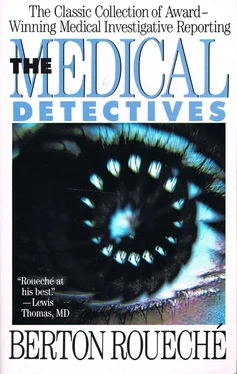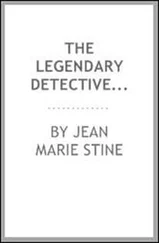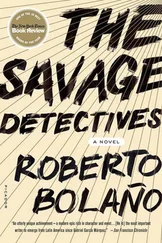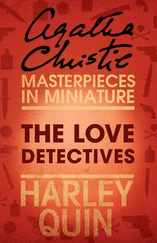Dogs suffer from three diseases: lyssa, quinsy, and sore feet," he noted. "Lyssa drives the animal mad, and any animal whatever, including man, will take the disease if bitten by a dog so afflicted; the disease is fatal to the dog itself, and to any animal it may bite, man excepted." Lyssa, a transliteration of Xucroa, means frenzy," and is the name by which rabies was originally known. The Romans gave the disease its modern name, which derives from rabere , the Latin for "to rage," and has been in common usage since the first Christian century.
The Romans also modernized the Greek conception of rabies. A gifted encyclopedist of the early empire named Aulus Cornelius Celsus was among the first to raise his eyes from the pages of Historia Animalium and look squarely at the world around him. Having done so, he proceeded to challenge the first of Aristotle's comfortable exceptions as myopically veterinarian. All animals, he decided in his classic De Medicina , were equally susceptible to rabies. Celsus was willing, however, to concede Aristotle's second exception. It was possible, his studies informed him, that the disease could be mastered in man. He then went on to propose a still valid preventive technique ("the wound. . . must be cauterized") and, less acutely, an antidote and a course of treatment. This consisted of thirty herbal ingredients (including poppy tears, lllyrian iris, Gallic nard, white pepper, male frankincense, and turpentine) mixed with honey and dissolved in a tumbler of wine. Its omission, he added, was risky. "When too little has been done for such a wound it usually gives rise to a fear of water," he wrote. "In these cases there is very little hope for the sufferer. But still there is just one remedy, to throw the patient unawares into a water tank which he has not seen beforehand. If he cannot swim, let him sink under and drink, then lift him out. If he can swim, push him under at intervals so that he drinks his fill of water even against his will. For so his thirst and dread of water are removed at the same time. Yet this procedure incurs a further danger, that a spasm of sinews, provoked by the cold water, may carry off a weakened body. Lest this should happen, he must be taken straight from the tank and plunged into a bath of hot oil."
Celsus's uneasy concession that rabies need not be fatal to man was accepted without recorded dispute for fifteen hundred years. So, except for certain pharmacological refinements, were his methods of breaking its hold. Pedanius Dioscorides, whose De Materia Medica was the standard pharmacopoeia throughout the Roman era, contented himself with offering two alternative antidotes. One was a draught of hippocampus, or sea-horse, ashes. The other had as its active principle the leaves of the bladder campion. "This, being beaten when it is green, with old swine's grease, is good for the mad-dog-bitten," he wrote. Rufus of Ephesus, a second-century physiologist, preferred a draught of "wormwood, aristolochia, Lycian thorn, decoction of river-crayfish, water germander, rock-parsley, and the root called gentian." Even Galen, the most observant, as well as the most imaginative, medical investigator in the millennia between Hippocrates and the Renaissance, had nothing to add to Celsus but a polished definition: "[Rabies] is a disease that follows the bite of a mad dog and is accompanied by an aversion to drinking liquids, convulsions, and hiccups. Sometimes maniacal attacks supervene."
After Galen, and the subsequent canonization of Greco-Roman medicine, the illumination of rabies, like that of all disease, was considered complete, and the subject complacently closed. The first attempt to reopen it was made in the sixteenth century. A Veronese savant named Hieronymus Fracastorius is usually celebrated for this act of desecration. Rabies, he announced in 1546, in his precocious Contagions, and Contagious Diseases and Their Treatment , was an infectious disease, always communicated by the injection of saliva into the blood, and, notwithstanding the protestations of pharmacy, always irremediably fatal. He also emphasized this novel conception of the disease in a dissertation on hunting dogs. "What particularly calls for the care of the skilled mind," he wrote, "is when, inflamed with rabies, [the dog] attacks now these, now those and, turning against the master himself, he inflicts the incurable wound." Fracastorius was a man of towering intellectual stature. In addition to being a notable physician, he was a poet (the term "syphilis" derives from his A Poetical History of the French Disease) , a botanist, a geographer, a musician, a mathematician, and an astronomer, and his morbid view of rabies received a respectful hearing. It even, for a time, attracted a few admirers. But hope and habit were too strong, and within a generation the more congenial classic conception resumed its interrupted vogue.
Celsus's hydrotherapeutic regimen, adapted to the ducking stool, was commonly prescribed in cases of rabies throughout the sixteenth and seventeenth centuries, and at least on occasion (an essay by Oliver Goldsmith, written around 1765, refers to "a little boy bit in the leg, and gone down to be dipped in the salt water") during much of the eighteenth century. His pharmacological influence continued even longer. In 1806, the New York State Legislature passed, without recorded opposition, a bill entitled "An Act for Granting a Compensation to John M. Crous, for Discovering and Publishing a Cure for the Canine Madness." Crous's cure, for which he was granted a thousand dollars, was a tablet to be swallowed with water. Its components included the pulverized jawbone of a dog, the dried false tongue of a newly foaled colt, and a pinch of corroded copper taken from an English penny minted in the reign of George I. Other American physicians of that time, perhaps less impressed by royalty, favored a remedy composed of bole armeniac, alum, chalk, elecampane, and black pepper. They also had confidence, as did many European doctors, in the curative powers of concretions, similar to kidney stones, that are sometimes found in the intestines of deer, goats, and other herbivorous animals and that, because they were used as a specific in the treatment of rabies, became known as madstones. Such concretions, being formed of mineral salts, are porous and somewhat absorbent. These qualities helped to support the belief that a madstone applied to a rabic wound would promptly extract the venom. "This afternoon called on by a man in Jeffersonville to apply the madstone to a little son bitten a day or two previous," an Indiana judge, soldier, and statesman named John McCoy noted in his journal on June 9, 1848. "Rode through' the rain and reached there about sunset. Induced to think the dog mad." In 1879, at an auction in Texas, a madstone brought two hundred and fifty dollars. That would be the equivalent of about a thousand dollars today.
The supposition that rabies could be cured by some curious pill or poultice expired with the nineteenth century. The absolute lethality of the disease is now universally accepted. One reason for this abrupt resignation to reality is that the evidence assembled by modern medical science leaves no room for doubt. Another is that the truth is no longer unbearable. Since the eighteen-eighties, when Pasteur was inspired to adapt to rabies his epochal discovery that the pathogenic properties of a microorganism can be attenuated (by drying, or treatment with certain chemicals, and passage through a succession of laboratory animals) without affecting its capacity to generate protective antibodies, a reliable means of hobbling the disease has been everywhere at hand.
Pasteur conceived the idea of rabies prophylaxis in 1880. By the end of 1883, he and his associates at the Ecole Normale, in Paris, were able to produce a stable strain of suitably domesticated virus. This was followed by two series of experiments establishing beyond dispute that the strain was immunologically effective in dogs. The first of these was brought to a brilliant close in June, 1884, with a formal trial before a committee of scientists appointed by the French Government. For this definitive test, Pasteur chose two previously vaccinated dogs, two untreated dogs, and two untreated rabbits. After being examined by the committee, the six animals were anesthetized and trephined. Each animal was then identically inoculated with a quantity of material drawn from the brain of a demonstrably rabid dog. When the operation was completed, the animals were separately confined, and all received the same postoperative care. Two weeks later, the four controls, or untreated animals, developed rabies, and died. The vaccinated dogs remained in normal health. The second series of experiments, though begun at about the same time, continued into the following year, and the results were equally emphatic. They showed that it was possible to immunize a dog against rabies not only before but, if the step was undertaken promptly, after exposure to the disease. Pasteur emerged from this revolutionary triumph with a vision of one even more revolutionary. "What I aspire to [now] is the possibility of treating a man after a bite with no fear of accidents," he wrote in the spring of 1885. ". . .I have not yet dared to treat human beings after bites from rabid dogs. But the time is not far off."
Читать дальше












